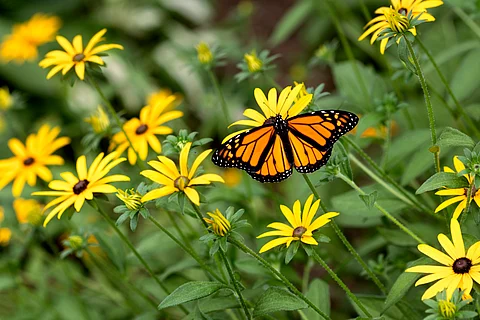

Butterflies in the United States are disappearing at an alarming rate, with a new study revealing a 22 per cent decline in their populations over the past two decades. Scientists warn that this dramatic loss signals an urgent need for conservation efforts to protect these essential pollinators from further decline.
The study found that out of 554 recorded butterfly species, two-thirds showed significant population declines. The research analysed records of 12.6 million individual butterflies and drew on over 76,000 surveys from 2,478 unique locations across 35 monitoring programmes between 2000 and 2020.
The findings, published in the journal Science, highlighted the widespread nature of the decline, with species-level losses occurring at a rate 13 times higher than any recorded increases in population.
Butterflies play a crucial role in nutrient cycling and serve as a vital food source for birds and other organisms, in addition to their role as pollinators.
“Over our two-decade study period, 33 per cent of individual butterfly species — that is 114 of 342 — showed significantly declining trends in abundance,” the study noted.
In stark contrast, only 3 per cent of species—nine in total—exhibited an increase in population.
A large number of species are facing severe losses, with 107 species experiencing declines of over 50 per cent, including 22 species that have lost more than 90 per cent of their population, the study said.
Focusing on the 342 species with adequate data for species-level population trends, the researchers found that two-thirds (245 species) had experienced a cumulative decline of over 10 per cent. Meanwhile, only one-fifth of species — 65 in total — showed a cumulative increase of more than 10 per cent.
“Declines were present across all butterfly families, with 60 to 75 per cent of species declining or possibly declining within each family,” the study said.
The study pointed to climate change as a key driver of butterfly population decline, alongside habitat loss and pesticide use.
“With climate change, butterfly species in North America may find the southern limits of their ranges becoming too warm while the northern limits of their range become more hospitable,” the study explained.
To test this theory, scientists compared population trends in species found in pairs of regions — one northern and one southern — with a shared east-west border. In three out of four region pairs, butterfly abundance was higher in the northern region.
The study also highlighted the role of pesticides, particularly insecticides, in butterfly declines. Recent analyses from California and the Midwestern US confirmed that pesticide use was a significant contributor to population losses.
Scientists behind the study recommended imposing restrictions on insecticide use, similar to those enacted by the European Union. They suggested that reducing pesticide use through integrated pest management and diversified cropping could help improve butterfly habitats and support broader insect conservation efforts.
Despite the alarming findings, researchers acknowledge limitations in their data. Of the nearly 650 butterfly species in the contiguous US, only 554 species (85 per cent) were recorded in the dataset and just 342 species (53 per cent) had sufficient data for species-level analysis.
“Even among those analysed, we lacked the power to detect significant trends for most species. Thus, it is possible that many more butterflies are being lost than is estimable because species with limited data are already rare, with small population sizes living in specialised habitats,” the authors stated.
They also acknowledged that the total geographic area covered by their data is poorly represented.
In a press statement, Elise Zipkin, a Red Cedar Distinguished Professor of quantitative ecology at Michigan State University and a co-author of the paper, stressed the urgency of intervention. “Action must be taken. To lose 22 percent of butterflies across the continental U.S. in just two decades is distressing and shows a clear need for broad-scale conservation interventions,” Zipkin stated.
Lead author Collin Edwards echoed this concern, stating: “For those who were not already aware of insect declines, this should be a wake-up call. We urgently need both local- and national-scale conservation efforts to support butterflies and other insects. We have never had as clear and compelling a picture of butterfly declines as we do now.”